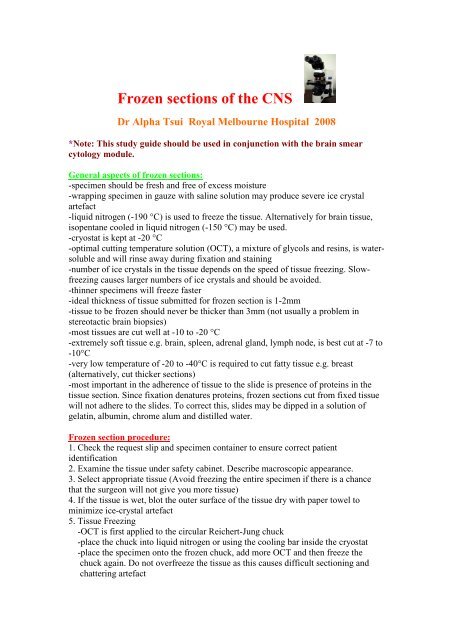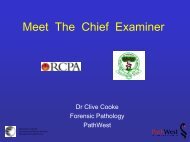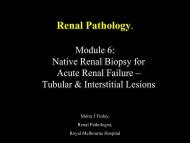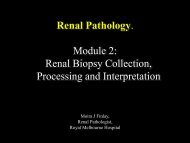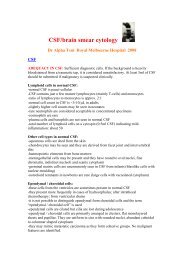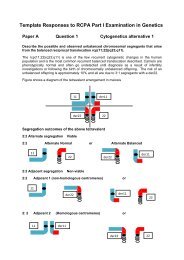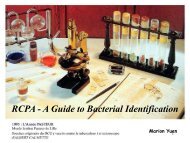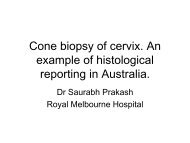Frozen sections CNS - Rcpa.tv
Frozen sections CNS - Rcpa.tv
Frozen sections CNS - Rcpa.tv
You also want an ePaper? Increase the reach of your titles
YUMPU automatically turns print PDFs into web optimized ePapers that Google loves.
<strong>Frozen</strong> <strong>sections</strong> of the <strong>CNS</strong><br />
Dr Alpha Tsui Royal Melbourne Hospital 2008<br />
*Note: This study guide should be used in conjunction with the brain smear<br />
cytology module.<br />
General aspects of frozen <strong>sections</strong>:<br />
-specimen should be fresh and free of excess moisture<br />
-wrapping specimen in gauze with saline solution may produce severe ice crystal<br />
artefact<br />
-liquid nitrogen (-190 °C) is used to freeze the tissue. Alternatively for brain tissue,<br />
isopentane cooled in liquid nitrogen (-150 °C) may be used.<br />
-cryostat is kept at -20 °C<br />
-optimal cutting temperature solution (OCT), a mixture of glycols and resins, is watersoluble<br />
and will rinse away during fixation and staining<br />
-number of ice crystals in the tissue depends on the speed of tissue freezing. Slowfreezing<br />
causes larger numbers of ice crystals and should be avoided.<br />
-thinner specimens will freeze faster<br />
-ideal thickness of tissue submitted for frozen section is 1-2mm<br />
-tissue to be frozen should never be thicker than 3mm (not usually a problem in<br />
stereotactic brain biopsies)<br />
-most tissues are cut well at -10 to -20 °C<br />
-extremely soft tissue e.g. brain, spleen, adrenal gland, lymph node, is best cut at -7 to<br />
-10°C<br />
-very low temperature of -20 to -40°C is required to cut fatty tissue e.g. breast<br />
(alternatively, cut thicker <strong>sections</strong>)<br />
-most important in the adherence of tissue to the slide is presence of proteins in the<br />
tissue section. Since fixation denatures proteins, frozen <strong>sections</strong> cut from fixed tissue<br />
will not adhere to the slides. To correct this, slides may be dipped in a solution of<br />
gelatin, albumin, chrome alum and distilled water.<br />
<strong>Frozen</strong> section procedure:<br />
1. Check the request slip and specimen container to ensure correct patient<br />
identification<br />
2. Examine the tissue under safety cabinet. Describe macroscopic appearance.<br />
3. Select appropriate tissue (Avoid freezing the entire specimen if there is a chance<br />
that the surgeon will not give you more tissue)<br />
4. If the tissue is wet, blot the outer surface of the tissue dry with paper towel to<br />
minimize ice-crystal artefact<br />
5. Tissue Freezing<br />
-OCT is first applied to the circular Reichert-Jung chuck<br />
-place the chuck into liquid nitrogen or using the cooling bar inside the cryostat<br />
-place the specimen onto the frozen chuck, add more OCT and then freeze the<br />
chuck again. Do not overfreeze the tissue as this causes difficult sectioning and<br />
chattering artefact
-the tissue is rapidly frozen to minimize ice-crystal artefact<br />
6. Tissue sectioning (5µm thick for brain tissue) using rotary microtome. Section<br />
pressed onto a glass slide.<br />
7. Slides must be immediately placed in fixative (about 30secs), not allowing airdrying<br />
to occur. For brain tissue: 95% ethanol is used. For non-neural tissue: 10%<br />
formalin / 95% ethanol (1:1 ratio) is used. A delay in fixation, even for several<br />
seconds, can significantly affect the cellular detail.<br />
8. Rapid H&E stain<br />
9. Dehydrate, clear, mount and coverslip<br />
10. Report to the surgeon and write down the diagnosis on the request slip<br />
11. Special studies (send remaining fresh tissue for culture, flow cytometry if<br />
indicated)<br />
12. The piece of frozen tissue should be then fixed in formalin and processed for<br />
paraffin section<br />
Rapid H&E stain for frozen section:<br />
-progressive staining<br />
1. fix <strong>sections</strong> in ethanol / formalin for 30 seconds<br />
2. rinse in water<br />
3. stain in Harris' haematoxylin for 30 sec<br />
4. rinse in water<br />
5. rinse in Scott's tap water<br />
6. rinse in water<br />
7. stain in eosin for 10 seconds<br />
8. dehydrate (in alcohol), clear, mount in DPX and coverslip<br />
Indications for <strong>CNS</strong> frozen <strong>sections</strong>:<br />
-to obtain adequate abnormal material for a diagnosis (including tissue for special<br />
studies e.g. microbiology)<br />
-to know the nature of the lesion: neoplastic or not; benign vs malignant; tumour<br />
typing (esp. lymphoma; primary vs metastatic); low grade vs high grade glioma (in<br />
some cases, the surgeon is trying to biopsy the contrast enhancing component of the<br />
lesion which may be high grade)<br />
-status of resection margins (not usually an issue with <strong>CNS</strong> tumours)<br />
Advantages of frozen section:<br />
-architecture of the tumours can be better assessed as compared to cytology smears<br />
-not a problem with firm tumours that are difficult to smear<br />
-can do multiple levels<br />
Disadvantages of frozen section:<br />
-prone to artefacts<br />
-some tumours are altered by the freezing procedure: oligodendroglioma, pilocytic<br />
astrocytoma, ganglion cell tumour, lymphoma<br />
-some tumours are difficult to cut e.g. bony / calcified lesions, cysts, fatty tissue<br />
-takes more time to prepare the slides<br />
-technically more difficult to have satisfactory <strong>sections</strong><br />
-more expensive<br />
-requires maintenance of the cryostat
-decontamination procedure takes a longer time and a spare cryostat is required<br />
Use of cytology smears:<br />
Advantages:<br />
-faster than doing a frozen section<br />
-ease of preparation<br />
-technically simple<br />
-nuclear detail is better seen with brain smears e.g. round nuclei of oligodendroglioma<br />
much better visualized; lymphoma; differentiation features of a carcinoma e.g.<br />
keratinisation<br />
-when infectious process is suspected, smears can be used to avoid contamination of<br />
the cryostat<br />
-only small amount of tissue is required<br />
-less artefacts as compared to frozen section<br />
Disadvantages:<br />
-some tumours are hard to smear e.g. schwannoma, meningioma, haemangioblastoma,<br />
neurofibroma, subependymoma, etc<br />
-cysts are better assessed with frozen section<br />
-some features are not seen e.g. vascular pattern of haemangioblastoma; perinuclear<br />
haloes of oligodendroglioma<br />
Technical problems and artefacts during frozen section:<br />
-ice crystal artefact (damage usually most prominent in the centre of the tissue):<br />
freezing too slow; tissue too wet; tissue too large to permit rapid freezing<br />
-chattering artefact: tissue too cold and too hard (e.g. calcified); specimen or blade<br />
poorly supported or adjusted; damaged blade; section too thick<br />
-folding artefact: section not straightened out when pressed onto the glass slide<br />
-pale staining: section dried out before putting the slide into fixative<br />
-section falling off the slide: fatty tissue; formalin-fixed tissue; small cauterized<br />
specimens; cartilage; necrotic tissue<br />
-tissue section adherence to knife edge: high block temperature, incorrectly positioned<br />
antiroll plate<br />
-contamination e.g. in OCT medium; fixative; staining solutions<br />
Decontamination procedure for the cryostat:<br />
-use formalin bomb: put concentrated formalin (40%) and potassium permanganate in<br />
the cryostat with lid closed overnight<br />
-the cryotome is removed the following day. The components are cleaned up with<br />
70% ethanol<br />
-the cryotome is placed into the 37°C incubator to allow thorough drying and then<br />
lubricated<br />
Approach to frozen <strong>sections</strong> of the <strong>CNS</strong>:<br />
1. check the radiology (site, size, single or multiple, solid or cystic, calcification,<br />
contrast enhancement or not), clinical history (esp. age, symptoms), previous biopsies,<br />
past treatment<br />
2. pick abnormal tissue for smear + frozen section – often has different consistency<br />
and colour from normal cortex/white matter
3. avoid freezing entire specimen (unless surgeon is happy to take more tissue later<br />
on)<br />
4. decide normal or abnormal (cellularity, architecture, cellular detail)<br />
5. if abnormal, is it benign or malignant<br />
6. if benign, is it specific ? e.g. infarct, abscess, benign neoplasm<br />
7. if possibly infectious, must ask surgeon for more tissue for microbiology (or submit<br />
unused tissue)<br />
8. if malignant, is it primary or metastatic<br />
9. if primary tumour, may need to give grading (low or high grade, look for mitoses,<br />
endothelial cell proliferation, necrosis)<br />
10. if secondary, is it carcinoma, melanoma, lymphoma or sarcoma<br />
11. if suspected lymphoma, ask for more tissue for flow cytometry<br />
12. communicate clearly to the surgeon; ask for more tissue if there is insufficient<br />
material for a diagnosis or if the lesion is entirely necrotic<br />
Normal:<br />
Normal cerebral cortex and white matter:<br />
-uniformly distributed neurons maintaining the normal architecture<br />
-astrocytes evenly spaced showing no nuclear atypia<br />
-oligodendrocytes may form linear rows in white matter tracts<br />
-deep layers of temporal or parietal cortex often show normal perineuronal satellitosis<br />
by oligodendrocytes. In oligodendroglioma, the number of these cells is increased and<br />
they have nuclear enlargement.<br />
Normal cerebellar cortex:<br />
-beware normal granule cells mimicking a small round blue tumour such as<br />
medulloblastoma or metastatic small cell carcinoma<br />
-normal granule cells are small and they have round nuclei. They don’t show nuclear<br />
moulding.<br />
-look for adjacent evenly spaced Purkinje cells<br />
Normal anterior pituitary gland:<br />
-uniformly packeted arrangement<br />
-cells show different size and staining properties<br />
-it is important to advise the surgeon if normal tissue has been removed during<br />
adenoma surgery as too much normal tissue resected will cause hypopituitism postoperatively<br />
Non-neoplastic lesions:<br />
Reactive gliosis:<br />
-characterised by evenly spaced astrocytes of uniform size with abundant eosinophilic<br />
cytoplasm and radiating long processes (neoplastic astrocytes have truncated or absent<br />
processes)<br />
-mitoses are morphologically normal and usually sparse<br />
-with time, reactive astrocytes become more densely fibrillated<br />
-do not form secondary structures: dense subpial, subependymal, perivascular and<br />
perineuronal aggregation not seen<br />
-microcysts are not a feature of reactive gliosis<br />
-if there are foamy macrophages or perivascular lymphocytes, a reactive process<br />
should be first considered
Infarct:<br />
-acute infarcts are not usually biopsied. Organising infarcts with ring enhancement,<br />
mimicking glioblastoma radiologically, are the ones for biopsy.<br />
-infarcts always involve the cerebral cortex<br />
-predominant cells are ovoid to polygonal lipid-rich histiocytes (gitter cells) with<br />
round nuclei and foamy cytoplasm<br />
-mitoses may be seen but are not atypical<br />
-aggregation of histiocytes in cuffs about the vasculature is common and is often<br />
accompanied by small numbers of lymphocytes or polymorphs<br />
-reactive astrocytes are large with prominent cell bodies and possess long processes<br />
-there is a proliferation of blood vessels and they can show endothelial cell<br />
hyperplasia. Thrombi may be present.<br />
-look for ischaemic neurons (pyknotic nuclei, dense hypereosinophilic cytoplasm)<br />
Demyelination:<br />
-the lesion is centered in the white matter<br />
-sheets of foamy histiocytes (may be difficult to see in some cases)<br />
-perivascular cuffs of lymphocytes a clue<br />
-neurons and their processes are intact<br />
-no ischaemic red neurons<br />
-necrosis is rare<br />
-no cavitation<br />
-final diagnosis requires clinical correlation and special stains for myelin and axons<br />
Do not misinterpret macrophages as gemistocytes. Foamy<br />
macrophages are seen in infarcts, demyelination disorders, vasculitis,<br />
Whipple’s disease, post-chemoradiotherapy and lymphomas esp. when<br />
steroids are given pre-operatively.<br />
Organising abscess:<br />
-circumscribed lesion with a liquefied centre<br />
-there are polymorphs, lymphocytes, plasma cells, histiocytes, broad areas of necrosis,<br />
plump reactive astrocytes and fibrocapillary proliferation<br />
-the lesion is characteristically zonated: centre of polymorphs; layers of necrotic<br />
tissue; foamy macrophages among reactive capillaries, monocytes, proliferating<br />
fibroblasts; intense reactive gliosis in surrounding brain<br />
-finding an organising collagenous capsule is a clue<br />
-beware reactive gliosis at the periphery, mimicking a glioma<br />
-endothelial cell hyperplasia can be prominent, forming a rim. This does not equate<br />
high grade glioma.<br />
If the features are suggestive of an abscess during frozen section, fresh tissue<br />
must be sent for microbiology. Paraffin <strong>sections</strong> may not show the organisms.<br />
Progressive multifocal leukoencephalopathy:
-histiocytes and reactive astrocytes may be numerous. The astrocytes may appear<br />
pleomorphic and multinucleated. Again, presence of foamy macrophages gives a clue<br />
that the lesion is probably not a glioma.<br />
-the pleomorphic astrocytes are usually single and they do not form cellular sheets<br />
-overall cellularity falls short of that seen in high grade astrocytoma<br />
-presence of diagnostic homogeneous glassy intranuclear inclusions in<br />
oligodendroglial cells<br />
-absence of microvascular proliferation, palisaded necrosis, secondary structures<br />
Prolapsed intervertebral disc:<br />
-degenerate granular amorphous acellular material (may mimic necrosis)<br />
-fibrosis may be seen<br />
-inflammation usually sparse<br />
Astrocytic tumours:<br />
Diffuse (low grade) astrocytoma:<br />
-Macro: grey with a hint of yellow; vary from soft, gelatinous to firm; cysts may be<br />
seen<br />
-increased cellularity<br />
-astrocytes are irregularly distributed, forming small clusters of a few cells<br />
-nuclear atypia seen: nuclear enlargement, hyperchromasia, irregular nuclear<br />
membrane<br />
-perineuronal satellitosis is a valuable clue: Atypical cells cluster around cortical<br />
neurons (not seen in reactive gliosis)<br />
-microcystic change seen with glioma rather than gliosis<br />
The freezing process may cause artefactual nuclear angulation and<br />
hyperchromasia. It can cause normal or gliotic tissue to look neoplastic; a<br />
grade II lesion appearing as a grade III.<br />
Anaplastic astrocytoma:<br />
-use the term “high grade astrocytoma” is sufficient at the time of frozen section<br />
-usually more cellular than diffuse astrocytoma<br />
-look for mitoses<br />
-may see endothelial cell hyperplasia<br />
-no necrosis<br />
Glioblastoma multiforme:<br />
-Macro: soft, grey to tan, may show increased vascularity or white-yellow necrotic<br />
areas<br />
-beware gliomas may be multifocal up to 10% of cases<br />
-cellular tumour with poorly defined cell borders in fibrillary background<br />
-look for mitoses, endothelial cell proliferation and necrosis<br />
-necrosis with pseudopalisading a characteristic feature<br />
-necrotic blood vessel also a good clue to GBM (more indicative of a neoplastic<br />
process, esp. when inflammatory cells are sparse)<br />
-abundant foamy macrophages or neutrophils are not seen in GBM and should suspect<br />
alternative diagnosis (non-neoplastic entities) if present
-giant cell variant may be deceptively well-circumscribed, mimicking a metastasis<br />
radiologically and surgically. It may also have perivascular lymphocytes.<br />
If the lesion is strongly suspicious for a GBM radiologically and the<br />
frozen section only shows low grade tumour or reactive gliosis, the tissue is<br />
most likely not representative of the lesion. Should request deeper tissue from<br />
the surgeon.<br />
Radionecrosis:<br />
-the issue with frozen section is to decide whether there is residual/recurrent glioma or<br />
not. The radiology usually shows new contrast enhancement, suspicious for tumour.<br />
-vascular damage is a prominent feature<br />
-fibrinoid necrosis is often widespread and accompanied by thrombosis<br />
-chronic changes include recanalisation and mural hyalinisation in addition to<br />
telangiectasia. Subendothelial foam cells are often present.<br />
-the degree of macrophage response is much less as compared with that in ischaemic<br />
infarct and demyelinating disease<br />
-granulation tissue often seen with chronic inflammation and haemosiderin deposits<br />
-reactive astrocytes are abundant and may show radiation atypia: nuclear and<br />
cytoplasmic enlargement, multinucleation, cytoplasmic vacuolisation<br />
Features favouring radionecrosis: areas of coagulative necrosis with no<br />
pseudopalisading by tumour cells; all the usual features of reactive gliosis;<br />
typical vascular and inflammatory changes.<br />
Features favouring tumour: cellular sheets of atypical cells; astrocytes<br />
have high N/C ratio and hyperchromasia; high mitotic rate; palisaded necrosis.<br />
Gliosarcoma:<br />
-Macro: focally firm and discrete (mimicking a metastasis or even a meningioma<br />
surgically)<br />
-biphasic pattern of more typical GBM and malignant spindled tumour cells, forming<br />
fascicles<br />
Pilocytic astrocytoma:<br />
-Macro: tough and rubbery; cysts containing clear fluid<br />
-typical biphasic pattern with dense spindled areas and microcysts<br />
-presence of multinucleated cells is a helpful clue<br />
-tumour looks less conspicuously “pilocytic” in frozen section than in paraffin section<br />
-some cells may have degenerative type change with marked nuclear pleomorphism,<br />
mimicking a high grade glioma<br />
-look for microcysts, hyalinised vessels, Rosenthal fibres, eosinophilic granular<br />
bodies<br />
-beware presence of glomeruloid microvascular proliferation which is common in<br />
pilocytic astrocytoma and should not overcall it as a high grade astrocytoma<br />
-correlate with the radiology (discrete, contrast-enhancing mural nodule in a cyst), site<br />
and age of the patient
Rosenthal fibres may be seen in the cyst wall of a haemangioblastoma or<br />
gliotic periphery of a craniopharyngioma, which may be potentially misdiagnosed<br />
as a pilocytic astrocytoma.<br />
Pleomorphic xanthoastrocytoma:<br />
-Macro: sharp interface with adjacent brain; yellow hue from lipids in the cytoplasm<br />
-despite the pleomorphic cells, mitoses, endothelial proliferation and necrosis are not<br />
present<br />
-the tumour cells may be elongated and may form vague fascicles<br />
-look for xanthomatous change in the cytoplasm<br />
-look for eosinophilic granular bodies<br />
-presence of perivascular lymphocytes is a clue<br />
-correlate with the radiology (superficial location, involving meninges, mural nodule<br />
in a cyst in 50% of the cases)<br />
Subependymal giant cell astrocytoma:<br />
-Macro: well-circumscribed, generally firm, may be calcified; grey to pink<br />
-usually protruding into the lateral ventricle near the foramen of Munro<br />
-large tumour cells with abundant cytoplasm (much larger than a gemistocyte)<br />
-some of the cells are more spindled<br />
-enlarged vesicular nuclei with prominent nucleoli, resembling neurons<br />
-the cells may arrange themselves around blood vessels forming perivascular<br />
pseudorosettes<br />
-no mitoses, endothelial cell hyperplasia or necrosis<br />
Oligodendroglial tumours:<br />
Oligodendroglioma:<br />
-Macro: gelatinous, soft; grey to pink; may have cystic change; some are gritty<br />
-oligodendrogliomas or oligoastrocytomas involve the cortex more commonly as<br />
compared to pure astrocytomas. Think oligodendroglioma if there is rather extensive<br />
cortical involvement.<br />
-perinuclear haloes (“fried egg” appearance) are not seen in frozen section (artefact of<br />
delayed fixation)<br />
-secondary structuring (perineuronal satellitosis, perivascular aggregation, subpial<br />
accumulation), mucin-filled microcysts, calcifications, chicken-wire vasculature are<br />
valuable clues<br />
-aggregation of tumour cells to form palisaded clusters may be seen<br />
-nuclei may be distorted by the freezing process but the round nuclear contour can<br />
still be appreciated in some cells<br />
-cell processes and gliofibrillary matrix are absent<br />
-correlate with the smears (round nuclei better appreciated in cytology preparation;<br />
look for absence of background fibrillary matrix)<br />
-in difficult cases, a diagnosis of ‘low grade glioma’ is reasonable. It makes no<br />
difference to the surgeon during surgery whether the tumour is astrocytoma or<br />
oligodendroglioma.<br />
-beware minigemistocytes / gliofibrillary oligodendrocytes. Should not immediately<br />
suggest mixed glioma.
Anaplastic oligodendroglioma:<br />
-Macro: yellow-white soft necrotic areas and haemorrhage<br />
-increased cellularity; mitoses; endothelial cell hyperplasia; necrosis<br />
-tumour cells may be more pleomorphic and losing the nuclear roundness. It may be<br />
difficult to distinguish from a high grade astrocytoma.<br />
<strong>Frozen</strong> section process produces nuclear angulation and<br />
hyperchromasia, making an oligodendroglioma appearing like an astrocytoma.<br />
In Grade II oligodendroglioma or oligoastrocytoma, the tumour may be densely<br />
cellular, easily mistaken for a high grade glioma. It is important to ask the<br />
surgeon for more tissue for paraffin section if the entire specimen has already<br />
been submitted for frozen.<br />
Ependymal tumours:<br />
Ependymoma:<br />
-Macro: sharply demarcated, soft and fleshy; may be gritty<br />
-tumour may look like a fibrillary astrocytoma on frozen section as the fibrillarity and<br />
gemistocytic-like quality of the cells are emphasized<br />
-perivascular pseudorosettes a clue (slender tapering cytoplasmic processes of the<br />
tumour cells oriented perpendicular to the blood vessels)<br />
-ependymal canal-like structures and true rosettes with lumina may be seen<br />
Myxopapillary ependymoma:<br />
-Macro: well-defined, soft, saccular mass<br />
-mucin is characteristically located within the walls of blood vessels and in turn,<br />
surrounded by collar of tumour cells<br />
Subependymoma:<br />
-Macro: bosselated (cauliflower-like), firm, white to tan; may be gritty; may show<br />
cysts or haemorrhage<br />
-look for clustering of nuclei, separated by dense fibrillary matrix<br />
-microcysts are common<br />
-hyalinised vessels frequently present<br />
-perivascular pseudorosettes are not seen in subependymomas<br />
Choroid plexus tumours:<br />
Choroid plexus papilloma:<br />
-Macro: very vascular; pink; tufted or fronded surface; friable, granular texture; may<br />
be gritty<br />
-increased cellularity, exceeding that of normal choroid plexus<br />
-papillary structures lined by multi-layered epithelial cells<br />
-apical surface is usually flat and lacks the typical “cobblestone” appearance of<br />
normal choroid plexus tissue<br />
-oncocytic change is a helpful clue to indicate choroid plexus origin of the lesion<br />
Choroid plexus carcinoma:<br />
-Macro: very haemorrhagic, friable; surface less obviously fronded; may have<br />
necrosis; calcification uncommon<br />
-marked architectural complexity with partially solid areas
-papillary structures with surface layer of columnar cells may be lost in poorly<br />
differentiated tumours<br />
-tumour cells are more pleomorphic<br />
-mitoses, vascular proliferation and necrosis present<br />
Neuronal and mixed neuronal-glial tumours:<br />
Ganglioglioma:<br />
-Macro: well-circumscribed, firm, gritty, grey<br />
-look for atypical ganglion cells: bi or multinucleation; cell clustering; loss of normal<br />
orientation<br />
-ganglion cells become smudged and distorted during freezing and are easily missed<br />
-the pleomorphic glial component may be more conspicuous and mistaken for a high<br />
grade astrocytoma<br />
-correlate with radiology (mural nodule in a cyst) to avoid potential misdiagnosis<br />
-eosinophilic granular bodies and perivascular lymphocytes are clues to the diagnosis<br />
-adjacent cortical dysplasia may be seen (losing normal architecture of the cortical<br />
layers)<br />
Beware entrapped residual neurons in astrocytomas, mimicking a<br />
ganglion cell tumour. The entrapped neurons show no cytologic atypia and<br />
they are evenly distributed.<br />
Central neurocytoma:<br />
-Macro: well-circumscribed; soft to gritty; tan; may be partly cystic<br />
-beware of the diagnosis in a typical location (intraventricular, near foramen of<br />
Munro)<br />
-columns or rosette-like arrangement of uniform tumour cells<br />
-areas of eosinophilic fibrillar matrix without nuclei a useful clue<br />
-the fibrillar zones are altered by the freezing process and may mimic necrosis<br />
-most cells have uniform round nuclei which may be distorted during the freezing<br />
process. Some cells show nuclear angulation and hyperchromasia.<br />
-perinuclear haloes not seen<br />
The main differential diagnosis is oligodendroglioma, which has an almost<br />
identical histological appearance. Intraventricular location and anuclear fibrillar areas<br />
favour a neurocytoma.<br />
Dysembryoplastic neuroepithelial tumour (DNET):<br />
-Macro: soft with mucoid areas<br />
-intracortical nodules may be seen<br />
-cords of oligodendroglial-like cells with interspersed mature neurons floating in pale<br />
mucoid matrix<br />
-calcification and Rosenthal fibres may be present<br />
-know the clinical history (long history of seizures) and the typical intracortical<br />
location<br />
Pineal region tumours:<br />
Pineocytoma:
-adequate to use the term “pineal parenchymal tumour” at the time of frozen section<br />
-may see pineocytomatous rosettes<br />
Pineoblastoma:<br />
-appears as undifferentiated tumour, forming diffuse sheets<br />
-rosettes of the pineocytic type not seen<br />
-tumour cells have high N/C ratio<br />
-high mitotic rate<br />
Embryonal tumours:<br />
Medulloblastoma and PNET:<br />
-Macro: highly vascular; soft (firmness indicates desmoplasia); grey-pink<br />
-highly cellular, mitotically active tumour forming sheets<br />
-Homer-Wright rosettes may be present<br />
-tumour cells have elongated nuclei which often show moulding<br />
Cranial and paraspinal nerve tumours:<br />
Schwannoma:<br />
-Macro: very firm, tan; may have yellow areas, cysts, haemorrhage<br />
-look for fascicles with nuclear palisading and Verocay bodies (Antoni A areas) and<br />
microcystic change (Antoni B areas)<br />
-secondary changes common: foamy macrophages, haemosiderin deposits<br />
-hyalinised, thick-walled blood vessels a clue (uncommon in fibrous meningioma)<br />
-beware ancient change (no mitoses)<br />
Neurofibroma:<br />
-Macro: firm, white<br />
-collagen bundles in-between cells with wavy nuclei<br />
-loose stroma with frequent mast cells<br />
Tumours of meningothelial cells:<br />
Meningioma:<br />
-Macro: white to tan, usually firm but can be soft; may be gritty<br />
-look for whorls, fascicles, psammoma bodies<br />
-tumour cells have intranuclear pseudoinclusions, uniform nuclear features<br />
-fibrous meningioma may be difficult to distinguish from schwannoma. Secondary<br />
change (foamy macrophages, haemosiderin deposits) is more commonly seen in<br />
schwannoma.<br />
Mesenchymal tumours:<br />
Haemangiopericytoma:<br />
-Macro: soft and red (highly vascular) as compared to pale and firm in meningioma<br />
-staghorn blood vessels on low-power a clue<br />
-densely cellular<br />
-high N/C ratio, ovoid nuclei<br />
-variable mitotic rate<br />
Primary melanocytic lesions:<br />
Malignant melanoma:<br />
-Macro: soft brown tissue with foci of haemorrhage and necrosis
-often form sheets with areas of haemorrhage in the background<br />
-tumour cells are pleomorphic with prominent nucleoli, intranuclear pseudoinclusions<br />
and pigmented cytoplasm<br />
Other tumours related to the meninges:<br />
Haemangioblastoma:<br />
-Macro: firm, dark red/yellow nodule; may be associated with a cyst containing clear<br />
fluid<br />
-the intricate vascular network of thin-walled small vessels is a clue<br />
-the foaminess of the cytoplasm in the stromal cells may not be obvious<br />
-presence of pleomorphic and hyperchromatic nuclei of the stromal cells may mimic a<br />
glioma<br />
-presence of fat supports the diagnosis of haemangioblastoma<br />
-correlate with the radiology (discrete, contrast-enhancing nodule in a cerebellar cyst)<br />
Haematopoietic tumours:<br />
Lymphoma:<br />
-Macro: soft, fleshy grey-tan with haemorrhage and necrosis<br />
-it is very important to make an accurate diagnosis of lymphoma. The surgeon will<br />
not need to further excise the tumour, once the lymphoma diagnosis is given.<br />
-tumour has distinct tendency to form perivascular cuffs – angiocentric invasion (not<br />
usually seen in gliomas)<br />
-histiocytes, reactive astrocytes, inflammatory cells may be numerous. The<br />
background reactive astrocytes may suggest a glioma.<br />
-the cytology of the tumour cells may be distorted by the freezing process, mimicking<br />
a glioma or metastatic carcinoma<br />
-crush artefact and prominent apoptotic debris are clues<br />
-the tumour cells often are large with scanty cytoplasm<br />
-correlate with the smears (nuclear detail much better seen)<br />
-in patients receiving pre-op steroids, the tumour cells may shrink<br />
Myeloma:<br />
-Macro: fleshy grey-purple<br />
-solid sheets of tumour cells<br />
-look for classic features of plasma cell differentiation: perinuclear hof, “clock-face”<br />
chromatin<br />
-Dutcher and Russell bodies<br />
Germ cell tumours:<br />
Germinoma:<br />
-Macro: soft to firm (depends on the amount of collagenous septa), grey-pink<br />
-large tumour cells with vesicular nuclei, prominent nucleoli and abundant cytoplasm<br />
-abundant lymphocytes may obscure the tumour cells (making a misdiagnosis of<br />
lymphocytic hypophysitis)<br />
-tumour cells may be crushed and difficult to see<br />
-granulomas may be present<br />
Lesions of the sellar region:<br />
Pituitary adenoma:<br />
-Macro: soft, tan (normal pituitary gland tissue is more rubbery)
-sheets, trabeculae, rosettes with vascularised stroma<br />
-monotonous population of cells with uniform nuclei and granular eosinophilic<br />
cytoplasm<br />
-some functioning adenomas may have pleomorphic tumour cells<br />
-in prolactinomas showing Bromocriptine effect, the tumour cells have high N/C<br />
ratio, resembling small cell carcinoma, lymphocytic hypophysitis or lymphoma<br />
-tumour cells are necrotic in pituitary apoplexy<br />
Pituitary hyperplasia:<br />
-Macro: slightly softer than normal tissue<br />
-acini expanded and becoming irregular in shape<br />
-the cells becoming more monotonous as compared to adjacent normal acini with a<br />
mixed population of cell types<br />
-better demonstrated with reticulin stain on paraffin <strong>sections</strong><br />
Lymphocytic hypophysitis:<br />
-Macro: tough, rubbery, pale<br />
-abundant lymphocytes and plasma cells<br />
-background of residual normal acini and fibrosis<br />
-look carefully for hidden tumour e.g. germinoma, spindle cell oncocytoma<br />
Craniopharyngioma:<br />
-Macro: solid, partly grey-white, firm, focally calcified; cystic part containing<br />
“machine oil” viscous brown fluid, glistened with minute cholesterol droplets<br />
-the tumour forms prominent multinodular epithelial lobules<br />
-cells at the periphery of the lobules are palisaded whereas internally situated cells<br />
show a stellate myxoid appearance<br />
-a diagnostic finding is wet keratin: nodules of plump, eosinophilic, keratinised cells<br />
-calcium is frequently seen in nodules of wet keratin<br />
-chronic inflammation and cholesterol clefts present<br />
-specimens obtained from the immediate periphery of a craniopharyngioma show<br />
Rosenthal fibre-rich gliosis which may mimic a pilocytic astrocytoma<br />
-wet preparation of cyst fluid may show characteristic birefringent layered polygonal<br />
cholesterol crystals<br />
Chordoma:<br />
-Macro: soft, translucent grey<br />
-cords of cells in myxomatous stroma<br />
-cytoplasmic vacuolation may be seen but not as striking as in paraffin <strong>sections</strong><br />
Rathke’s cleft cyst:<br />
-cyst lined by single-layered cuboidal or columnar ciliated epithelium<br />
Metastatic tumours:<br />
Metastatic carcinoma:<br />
-Macro: soft (may be firm due to desmoplasia), granular; may be necrotic; mucoid if<br />
adenocarcinoma<br />
-characteristically circumscribed, multiple<br />
-abrupt, sharply demarcated tumour margins that push into rather than wildly infiltrate<br />
the parenchyma
-endothelial cell hyperplasia not a common feature (usually at the periphery of the<br />
lesion if present). In GBM, it is seen throughout the tumour.<br />
-palisaded necrosis may be seen but not as frequent as in GBMs<br />
-if necrotic, residual viable tumour often forms cuffs around blood vessels<br />
-tumour cells have well-defined cell borders<br />
-collagenous stroma is seen, instead of fibrillary background<br />
-look for specific features of differentiation: glands, mucin, keratinisation,<br />
intercellular bridges<br />
Common secondary tumours of the <strong>CNS</strong>: carcinomas of the lung, breast,<br />
GIT, kidney; melanoma; lymphoma / leukaemia.<br />
Typically haemorrhagic metastatic tumours to the <strong>CNS</strong>: melanoma,<br />
choriocarcinoma, renal cell carcinoma, vascular neoplasms e.g. angiosarcoma.<br />
Metastatic small cell carcinoma:<br />
-Macro: soft, tan, necrotic<br />
-extensive necrosis present<br />
-lack desmoplastic growth pattern of medulloblastoma<br />
-show less tendency to rosette formation<br />
-high N/C ratio, nuclear moulding, granular chromatin, inconspicuous nucleoli<br />
-tumour cells often show crush artefact<br />
-high mitotic activity<br />
-Azzopardi effect<br />
Metastatic melanoma:<br />
-Macro: soft, typically haemorrhagic; may be brown or black<br />
-sheets and loosely cohesive tumour cells<br />
-cells with pleomorphic nuclei, intranuclear pseudoinclusions, prominent nucleoli, binucleation,<br />
abundant cytoplasm<br />
-cytoplasmic brown melanin pigment may be seen<br />
Cysts of the <strong>CNS</strong>:<br />
Colloid cyst:<br />
-lined by ciliated columnar epithelium with goblet cells<br />
Epidermoid cyst:<br />
-lined by multi-layered squamous epithelium with keratinisation<br />
Dermoid cyst:<br />
-lined by keratinised squamous epithelium<br />
-sebaceous glands, sweat glands, hair follicles in the cyst wall<br />
Endodermal (enterogenous, neuroenteric) cyst:<br />
-lined by respiratory or intestinal type epithelium with goblet cells<br />
Arachnoid cyst:<br />
-lined by meningothelial cells<br />
Ependymal (glioependymal) cyst:
-lined by ciliated ependymal cells<br />
-cilia often lost<br />
FALSE POSITIVES:<br />
-granular cell layer of the cerebellum mistaken for small round blue cell tumour<br />
-normal architecture of anterior pituitary gland not appreciated, overcalling as<br />
adenoma<br />
-calling normal arachnoid cell clusters in leptomeninges as a meningioma<br />
-reactive astrocytosis mistaken for astrocytoma; gliosis with Rosenthal fibres,<br />
overcalling as pilocytic astrocytoma<br />
-reactive lymphocytes, perivascular lymphocytes mimicking a lymphoma<br />
-infarct, demyelination plaque: foamy macrophages mistaken for gemistocytes<br />
FALSE NEGATIVES:<br />
-sampling error: by surgeon or pathologist picking non-tumour tissue for freezing<br />
-tumour obscured by frozen section artefacts (esp. too many ice crystals make tumour<br />
appearing as less cellular)<br />
-low grade astrocytoma<br />
-necrotic tumour<br />
-lymphocytes and granulomas obscuring a germinoma<br />
PRACTICAL TIPS:<br />
1. Know the clinical history, radiology and previous biopsies. Correlate with the brain<br />
smears.<br />
2. The most important indication for frozen section is to get enough tissue for<br />
histology rather than making a specific diagnosis on the spot.<br />
3. Microcysts have round circular profile. Ice crystal artefact has cleft-like, elongated<br />
appearance (may mimic microcystic change, overcalling normal / reactive lesion as<br />
low grade astrocytoma).<br />
4. If there are abundant neutrophils, the lesion is probably infectious rather than<br />
neoplastic. Must submit fresh tissue for culture.<br />
5. If there are prominent perivascular lymphocytes, think about vasculitis, viral<br />
infection, infarct, demyelination, lymphoma. Primary tumours with perivascular<br />
lymphocytes include ganglioglioma, pleomorphic xanthoastrocytoma and sometimes<br />
GBM (gemistocyte-rich or giant cell variant).
6. Features favouring low grade astrocytoma over reactive gliosis: clustering,<br />
crowding of astrocytes; definite nuclear atypia (nuclear irregularity, hyperchromasia,<br />
nuclear enlargement); absence of radiating long cytoplasmic processes; microcysts;<br />
absence of red neurons, foamy macrophages, perivascular lymphocytes.<br />
7. Vascular proliferation with endothelial cell hyperplasia is not specific to high grade<br />
astrocytomas. It may be seen at the edge of an organizing infarct / abscess, low grade<br />
tumours such as pilocytic astrocytoma, metastasis e.g. renal cell carcinoma.<br />
8. Palisaded necrosis is seen in tumours (typically GBMs, some metastases) and it is<br />
not present in an infarct or abscess. Radionecrosis is also unaccompanied by<br />
pseudopalisading.
Fig 1. Calcified tissue difficult to cut and severely fragmented during sectioning.<br />
Fig 2. Air-drying artefact. The cells show pale staining due to excessive air-drying<br />
prior to putting the slide into formalin fixation.
Fig 3. Chattering artefact. Parallel torn spaces.<br />
Fig 4. Ice crystal artefact with elongated spaces (Arrow).
Fig 5. Folding artefact. Section not straightened out before putting onto the slide<br />
(Arrow).<br />
Fig 6. Normal white matter with evenly distributed astrocytes.
Fig 7. Normal cerebral cortex with neurons and glial cells.<br />
Fig 8. Normal cerebral cortex, containing neurons.
Fig 9. Normal cerebellar cortex. Small granule cells with round nuclei. Note: evenly<br />
spaced Purkinje cells.<br />
Fig 10. Reactive gliosis with increased numbers of evenly distributed astrocytes.
Fig 11. Reactive gliosis. Evenly distributed astrocytes with mild nuclear enlargement.<br />
Fig 12. Reactive astrocytes with radiating cytoplasmic processes (Arrows).
Fig 13. Cerebral infarct with ischaemic neurons (Arrows).<br />
Fig 14. Cerebral abscess. Necrotic debris and neutrophils. Abundant neutrophils are<br />
usually not seen in GBM. Be sure to submit tissue for microbiology.
Fig 15. Cerebral abscess. Central necrosis (Yellow arrow), surrounded by reactive<br />
gliosis (Blue arrow).<br />
Fig 16. Cerebral abscess with reactive gliosis. There is no palisaded necrosis.
Fig 17. Cryptococcus.<br />
Fig 18. Demyelination.
Fig 19. Demyelination. Reactive astrocytes with processes (Blue arrows) and<br />
perivascular lymphocytes (Yellow arrow).<br />
Fig 20. Progressive multifocal leukoencephalopathy.
Fig 21. Progressive multifocal leukoencephalopathy. Oligodendroglial cells with<br />
round glassy intranuclear inclusions.<br />
Fig 22. Progressive multifocal leukoencephalopathy. Scattered reactive astrocytes are<br />
seen, which may show prominent nuclear pleomorphism.
Fig 23. Low grade astrocytoma.<br />
Fig 24. Low grade astrocytoma. Neoplastic astrocytes unevenly distributed.
Fig 25. Low grade astrocytoma. Neoplastic astrocytes show focal crowding.<br />
Fig 26. Pilocytic astrocytoma. Rosenthal fibres (Yellow arrow) and hyalinised blood<br />
vessels (Orange arrow).
Fig 27. Pilocytic astrocytoma.<br />
Fig 28. Pleomorphic xanthoastrocytoma. Can quite easily overcall this as a high grade<br />
astrocytoma on low-power.
Fig 29. Pleomorphic xanthoastrocytoma. Note perivascular lymphocytes.<br />
Fig 30. Pleomorphic xanthoastrocytoma. Eosinophilic granular body (Arrow).
Fig 31. High grade astrocytoma. Astrocytes with prominent nuclear atypia.<br />
Fig 32. High grade astrocytoma. Endothelial cell hyperplasia (Arrows).
Fig 33. Glioblastoma multiforme with palisaded necrosis.<br />
Fig 34. Radionecrosis. Note fibrinoid necrosis of the blood vessels.
Fig 35. Radiotherapy effect. The neuropil is often fibrous, containing chronic<br />
inflammatory cells, blood vessels and haemosiderin deposits.<br />
Fig 36. Residual/recurrent glioma post radiotherapy. The tumour cells often appear<br />
small with high N/C ratio.
Fig 37. Gliosarcoma containing spindled tumour cells.<br />
Fig 38. Oligodendroglioma. Scattered tumour cells have round nuclei.
Fig 39. Oligodendroglioma with subpial accumulation.<br />
Fig 40. Oligodendroglioma with perineuronal satellitosis.
Fig 41. Oligodendroglioma. Tumour nuclei are altered by the freezing process<br />
(becoming angulated and hyperchromatic).<br />
Fig 42. Ependymoma. Perivascular pseudorosettes (Arrows).
Fig 43. Myxopapillary ependymoma. Mucoid material in and surrounding central<br />
blood vessels.<br />
Fig 44. Subependymoma. Clustering of nuclei.
Fig 45. Subependymoma.<br />
Fig 46. Choroid plexus papilloma.
Fig 47. Ganglioglioma with abnormally clustered ganglion cells (Arrows).<br />
Fig 48. Central neurocytoma. The typical intraventricular location is a helpful clue to<br />
the diagnosis.
Fig 49. Central neurocytoma. The nuclear contour may become irregular during the<br />
freezing process. Perinuclear haloes are not seen.<br />
Fig 50. Central neurocytoma. Anuclear fibrillary zones present.
Fig 51. Pineal parenchymal tumour. Paraffin <strong>sections</strong> show intermediate<br />
differentiation.<br />
Fig 52. Medulloblastoma.
Fig 53. Medulloblastoma. Tumour cells with nuclear moulding.<br />
Fig 54. Schwannoma. Spindled cells with palisading (Antoni A area). Thick-walled<br />
blood vessels are commonly seen.
Fig 55. Schwannoma with haemosiderin deposits and foamy macrophages.<br />
Fig 56. Neurofibroma. Tumour cells have wavy nuclei.
Fig 57. Meningioma.<br />
Fig 58. Meningioma. Intranuclear pseudoinclusions appearing as clear holes.
Fig 59. Meningioma with brain invasion. Rosenthal fibres present (Arrow).<br />
Fig 60. Malignant meningioma, mimicking a sarcoma.
Fig 61. Haemangiopericytoma with dense cellularity.<br />
Fig 62. Haemangioblastoma. Prominent vascular network.
Fig 63. Haemangioblastoma. Stromal cells with foamy cytoplasm.<br />
Fig 64. Normal anterior pituitary gland tissue.
Fig 65. Normal anterior pituitary gland tissue with packeted arrangement. The cells<br />
show different staining properties.<br />
Fig 66. Pituitary adenoma with vascularised stroma.
Fig 67. Pituitary adenoma. Uniform population of tumour cells with abundant<br />
granular cytoplasm.<br />
Fig 68. Prolactinoma with Bromocriptine effect. The tumour cells may look like a<br />
small cell carcinoma or lymphoma.
Fig 69. Craniopharyngioma.<br />
Fig 70. Craniopharyngioma with wet keratin.
Fig 71. Lymphocytic hypophysitis with many mature lymphocytes.<br />
Fig 72. Chordoma.
Fig 73. Non-Hodgkin lymphoma. Cuffs of lymphoid cells around blood vessels.<br />
Fig 74. Non-Hodgkin lymphoma.
Fig 75. Myeloma with neoplastic plasma cells.<br />
Fig 76. Metastatic carcinoma (breast). Cribriform structures present. Tumour nests<br />
have well-defined edge.
Fig 77. Metastatic small cell carcinoma to the cerebellum. The tumour aggregates<br />
have well-defined borders and do not merge into the adjacent neuropil.<br />
Fig 78. Metastatic small cell carcinoma to the cerebellum.
Fig 79. Metastatic carcinoma. Viable tumour cells often show perivascular cuffing in<br />
areas of necrosis. This pattern is less commonly seen in gliomas.<br />
Fig 80. Metastatic melanoma, associated with prominent areas of haemorrhage.
Fig 81. Metastatic melanoma. Tumour cells with intranuclear pseudoinclusions<br />
(Arrows) and abundant eosinophilic cytoplasm.
References<br />
Yachnis AT. Intraoperative consultation for nervous system lesions. Sem Diag Pathol<br />
2002;19(4):192-206.<br />
Moss TH et al. Intra-operative diagnosis of <strong>CNS</strong> tumours. Arnold publishers. 1997.<br />
Burger PC et al. Surgical pathology of the nervous system and its coverings. ed.<br />
2002.<br />
Burger PC, Scheithauer BW. Tumors of the central nervous system. AFIP Series 4.<br />
2007.


